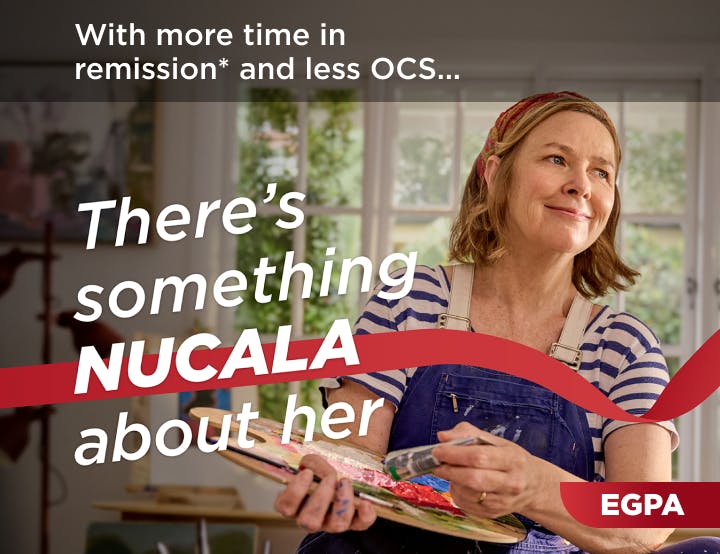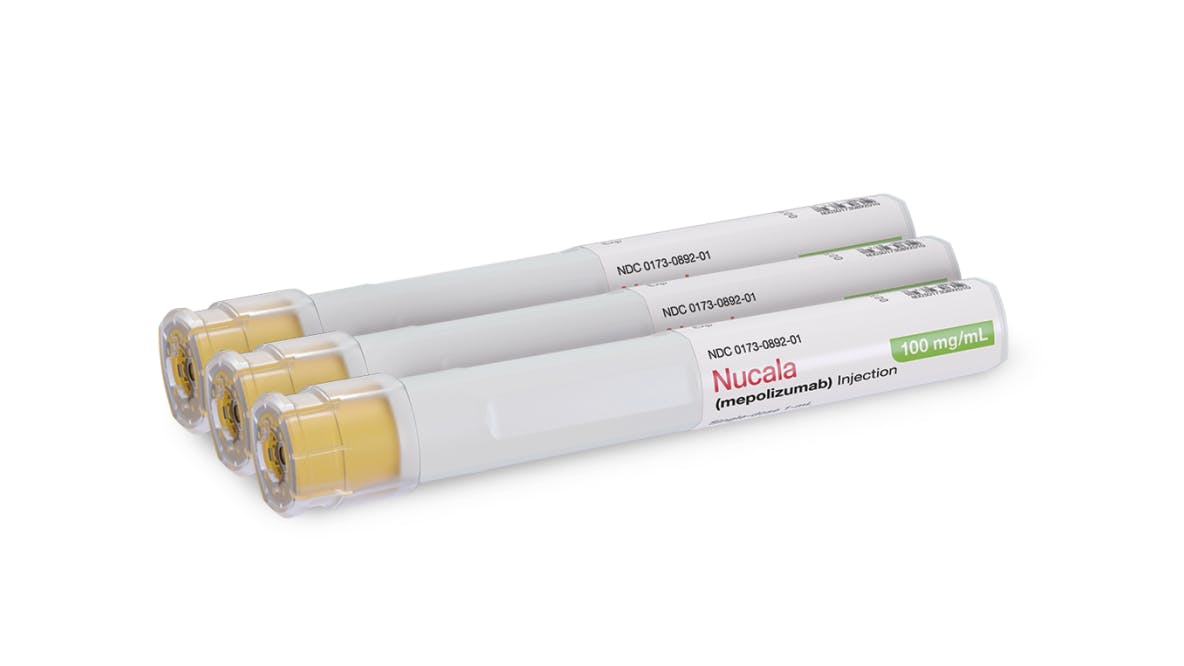ONSCREEN TEXT
Identifying Eosinophilic Granulomatosis With Polyangiitis and Hypereosinophilic Syndrome
Dr. O'Connor was a paid consultant for GSK at the time of filming.
DR. O’CONNOR:
In this chapter, I will review the similarities and differences between eosinophilic granulomatosis with polyangiitis and hypereosinophilic syndrome, and how to identify these diseases in your patients.
First, please listen as the narrator reviews the Indications and Important Safety Information for NUCALA (mepolizumab).
ONSCREEN TEXT
INDICATIONS AND IMPORTANT SAFETY INFORMATION
SEA
add-on maintenance treatment of adult and pediatric patients aged 6 years and older with severe asthma and with an eosinophilic phenotype. NUCALA is not indicated for the relief of acute bronchospasm or status asthmaticus.
CRSwNP
add-on maintenance treatment of chronic rhinosinusitis with nasal polyps (CRSwNP) in adult patients 18 years of age and older with inadequate response to nasal corticosteroids.
EGPA
treatment of adult patients with eosinophilic granulomatosis with polyangiitis (EGPA).
HES
treatment of adult and pediatric patients aged 12 years and older with hypereosinophilic syndrome (HES) for ≥6 months without an identifiable non-hematologic secondary cause.
IMPORTANT SAFETY INFORMATION
CONTRAINDICATIONS
Known hypersensitivity to mepolizumab or excipients.
Additional Important Safety Information will be presented later in this video.
Please see full Prescribing Information and Patient Information for NUCALA at the adjacent links or visit NucalaHCP.com.
NUCALA injection is available as a 100-mg/mL vial, autoinjector, and prefilled syringe.
NARRATOR:
NUCALA is indicated for the:
add-on maintenance treatment of adult and pediatric patients aged 6 years and older with severe asthma and with an eosinophilic phenotype. NUCALA is not indicated for the relief of acute bronchospasm or status asthmaticus.
add-on maintenance treatment of chronic rhinosinusitis with nasal polyps (CRSwNP) in adult patients 18 years of age and older with inadequate response to nasal corticosteroids.
treatment of adult patients with eosinophilic granulomatosis with polyangiitis (EGPA).
treatment of adult and pediatric patients aged 12 years and older with hypereosinophilic syndrome (HES) for greater than or equal to 6 months without an identifiable non-hematologic secondary cause.
Contraindications: Known hypersensitivity to mepolizumab or excipients.
Additional Important Safety Information will be presented later in this video.
DR. O’CONNOR:
In this chapter, I discuss EGPA, formerly known as Churg-Strauss syndrome, and HES indications for NUCALA.
ONSCREEN TEXT
Peripheral Blood Eosinophilia Is Associated With Several Diseases1-10
Asthma and allergic conditions, usually <1500 cell/μL
[arrow]
Single-organ eosinophilic (eg, eosinophilic asthma), blood eosinophil count varies
[arrow]
[arrow] Increasing blood eosinophil count
EGPA >10% eosinophilia: A rare disease defined as an eosinophil-rich, necrotizing granulomatous vasculitis affecting small- to medium-sized vessels and associated with asthma
[arrow]
HES>1500 cell/μL: A rare disease defined by hypereosinophilia with no secondary cause and eosinophil-mediated organ dysfunction
Other conditions include infections, drug reactions, and hematologic and neoplastic disorders
Sustained blood eosinophilia (>1500 cell/μL) without an apparent cause should prompt a workup and consideration of hypereosinophilic syndromes7
DR. O’CONNOR:
Peripheral blood eosinophilia is associated with a variety of conditions. Increasing blood eosinophil counts play a role in rarer eosinophil-driven diseases such as EGPA, which is associated with greater than 10% eosinophilia. EGPA is defined as having eosinophil-rich necrotizing granulomatous vasculitis, which affects small- to medium-sized vessels and is associated with asthma.
HES is also a rare disease defined by hypereosinophilia, with a blood eosinophil count greater than 1500 cells per microliter, no known secondary cause of the hypereosinophilia, and eosinophil-mediated organ dysfunction.
It is important that sustained blood eosinophilia without an apparent cause prompt a workup and consideration of hypereosinophilic syndromes.
ONSCREEN TEXT
EGPA vs HES: Similarities and Differences
EGPA and HES are both rare eosinophil-driven diseases.11-13 These disease states can overlap in their characteristics and clinical manifestations.13
Similarities Between EGPA and HES11,14:
Patient eosinophilia
Systemic manifestations
Differing Characteristics of EGPA from HES11:
Frequent asthma and nasal polyps
Vasculitic complications
~40% of patients ANCA-positive
DR. O’CONNOR:
EGPA and HES are rarer diseases in the spectrum of eosinophilia, and it can be difficult to differentiate between them. Both patients with EGPA and those with HES have persistent eosinophilia and present with systemic manifestations. However, there are some distinctive features between the 2 diseases, as noted on the screen.
ONSCREEN TEXT
2022 ACR/EULAR Classification Criteria for EGPA15
[table]
Clinical criteria: Score
Obstructive airway disease: +3
Nasal polyps: +3
Mononeuritis multiplex: +1
Laboratory/biopsy criteria: Score
BEC: +5
Extravascular eosinophilic-predominant inflammation on biopsy: +2
Positive test for cANCA or anti-PR3 antibodies: -3
Hematuria: -1
In these classification criteria, a cumulative score of ≥6 points yields an 85% sensitivity and 99% specificity for EGPA15*
*These criteria are meant for classification and not diagnostic purposes. These criteria should be applied when a diagnosis of small- or medium-vessel vasculitis has been made. Alternative diagnoses mimicking vasculitis should be excluded prior to applying these criteria.
DR: O’CONNOR:
With no accepted diagnostic criteria for EGPA, its diagnosis is based on the clinical and laboratory or biopsy criteria shown on screen. In the 2022 ACR and EULAR classification criteria, a cumulative score of greater than or equal to 6 points yields an 85% sensitivity and 99% specificity for EGPA. These criteria are meant for classification and not diagnostic purposes.
ONSCREEN TEXT
Hypereosinophilia and HES Definitions
Definition of Hypereosinophilia4,13
BEC >1500 cell/μL on ≥2 occasions with an interval of ≥1 month
and/or
Histologically proven eosinophilia in tissue (≥1 of the following):
Bone marrow aspiration with ≥20% eosinophils
Histologically proven tissue infiltration
Deposition of eosinophil-granule proteins
Definition of HES4,13
Criteria for peripheral blood hypereosinophilia fulfilled†
And
Eosinophil-mediated organ dysfunction and/or damage
And
No other identifiable etiology for eosinophilic
HES is a rare disease, with an estimated prevalence of 5000 patients in the US12‡
†In the case of evolving, life-threatening, end-organ damage, the diagnosis of HES can be made immediately to avoid delay in therapy.
‡Estimate based on the National Hospital Discharge Survey of ~6000 discharges with ≥1 discharge diagnosis with the ICD code for eosinophilia; ~2000 cases were compatible with HES. The ratio of outpatients to inpatients (2.5:1) from a US claims database was applied to determine the final estimate.
DR. O’CONNOR:
To better identify HES, we need to understand the distinction between hypereosinophilia and HES.
Hypereosinophilia is defined as a blood eosinophil count of greater than 1500 cells per microliter on at least 2 occasions occurring at least 1 month apart, and/or histologically proven eosinophilia evident in tissues in 1 or more of the ways noted on the screen.
HES has multiple components to its definition. When diagnosing HES, note that the criteria for peripheral blood hypereosinophilia must be fulfilled first.
Two additional criteria must be met to make the HES diagnosis. There must be evidence of eosinophil-mediated organ dysfunction and/or damage. Also, any other identifiable causes for eosinophilic organ damage must be ruled out.
This distinction is important because HES is a rare disease and can be difficult to diagnose. Note that in cases of evolving, life-threatening end-organ damage, the diagnosis of HES must be made immediately to avoid a delay in therapy.
ONSCREEN TEXT
Visit NucalaHCP.com
Continue watching for additional Important Safety Information.
DR. O’CONNOR:
To learn about the efficacy and safety data of NUCALA for EGPA and HES, please visit NucalaHCP.com. You can review patient profiles, study designs, and results of a double-blind, placebo-controlled trial with NUCALA 300 mg for each of these diseases. Now, please listen as the narrator presents additional Important Safety Information for NUCALA.
ONSCREEN TEXT
IMPORTANT SAFETY INFORMATION (continued.)
WARNINGS AND PRECAUTIONS
Hypersensitivity Reactions:
Hypersensitivity reactions (eg, anaphylaxis, angioedema, bronchospasm, hypotension, urticaria, rash) have occurred with NUCALA (mepolizumab). These reactions generally occur within hours of administration but can have a delayed onset (ie, days). Discontinue if a hypersensitivity reaction occurs.
Acute Asthma Symptoms or Deteriorating Disease: NUCALA should not be used to treat acute asthma symptoms, acute exacerbations, or acute bronchospasm.
Opportunistic Infections: Herpes Zoster: Herpes zoster infections have occurred in patients receiving NUCALA. Consider vaccination if medically appropriate.
Please see Important Safety Information for NUCALA throughout this video.
Please see full Prescribing Information and Patient Information for NUCALA at the adjacent links or visit NucalaHCP.com.
NARRATOR:
IMPORTANT SAFETY INFORMATION (continued.)
WARNINGS AND PRECAUTIONS.
Hypersensitivity Reactions:
Hypersensitivity reactions (for example, anaphylaxis, angioedema, bronchospasm, hypotension, urticaria, rash) have occurred with NUCALA. These reactions generally occur within hours of administration but can have a delayed onset (that is, days). Discontinue if a hypersensitivity reaction occurs.
Acute Asthma Symptoms or Deteriorating Disease: NUCALA should not be used to treat acute asthma symptoms, acute exacerbations, or acute bronchospasm.
Opportunistic Infections: Herpes Zoster: Herpes zoster infections have occurred in patients receiving NUCALA. Consider vaccination if medically appropriate.
ONSCREEN TEXT
IMPORTANT SAFETY INFORMATION (cont’d)
WARNINGS AND PRECAUTIONS (cont’d)
Reduction of Corticosteroid Dosage: Do not discontinue systemic or inhaled corticosteroids abruptly upon initiation of therapy with NUCALA. Decreases in corticosteroid doses, if appropriate, should be gradual and under the direct supervision of a physician. Reduction in corticosteroid dose may be associated with systemic withdrawal symptoms and/or unmask conditions previously suppressed by systemic corticosteroid therapy.
Parasitic (Helminth) Infection: Treat patients with pre-existing helminth infections before initiating therapy with NUCALA. If patients become infected while receiving NUCALA and do not respond to anti-helminth treatment, discontinue NUCALA until infection resolves.
Please see Important Safety Information for NUCALA throughout this video.
Please see full Prescribing Information and Patient Information for NUCALA at the adjacent links or visit NucalaHCP.com.
NARRATOR:
Reduction of Corticosteroid Dosage: Do not discontinue systemic or inhaled corticosteroids abruptly upon initiation of therapy with NUCALA. Decreases in corticosteroid doses, if appropriate, should be gradual and under the direct supervision of a physician. Reduction in corticosteroid dose may be associated with systemic withdrawal symptoms and/or unmask conditions previously suppressed by systemic corticosteroid therapy.
Parasitic (Helminth) Infection: Treat patients with pre-existing helminth infections before initiating therapy with NUCALA. If patients become infected while receiving NUCALA and do not respond to anti-helminth treatment, discontinue NUCALA until infection resolves.
ONSCREEN TEXT
IMPORTANT SAFETY INFORMATION (cont’d)
ADVERSE REACTIONS
The most common adverse reactions (≥5%) in patients receiving NUCALA (mepolizumab):
Severe asthma trials: headache, injection site reaction, back pain, fatigue
CRSwNP trial: oropharyngeal pain and arthralgia
EGPA and HES trials (300 mg of NUCALA): no additional adverse reactions were identified to those reported in severe asthma clinical trials
Systemic reactions, including hypersensitivity, occurred in clinical trials in patients receiving NUCALA. Manifestations included rash, pruritus, headache, myalgia, flushing, urticaria, erythema, fatigue, hypertension, warm sensation in trunk and neck, cold extremities, dyspnea, stridor, angioedema, and multifocal skin reaction. A majority of systemic reactions were experienced the day of dosing.
Please see Important Safety Information for NUCALA throughout this video.
Please see full Prescribing Information and Patient Information for NUCALA at the adjacent links or visit NucalaHCP.com
NARRATOR:
ADVERSE REACTIONS:The most common adverse reactions, defined as greater than or equal to 5%, in patients receiving NUCALA in the severe asthma trials were headache, injection site reaction, back pain, fatigue. Those in the CRSwNP trial were oropharyngeal pain and arthralgia. In the EGPA and HES trials with 300 mg of NUCALA, no additional adverse reactions were identified to those reported in severe asthma clinical trials.
Systemic reactions, including hypersensitivity, occurred in clinical trials in patients receiving NUCALA. Manifestations included rash, pruritus, headache, myalgia, flushing, urticaria, erythema, fatigue, hypertension, warm sensation in trunk and neck, cold extremities, dyspnea, stridor, angioedema, and multifocal skin reaction. A majority of systemic reactions were experienced the day of dosing.
ONSCREEN TEXT
IMPORTANT SAFETY INFORMATION (cont’d)
USE IN SPECIFIC POPULATIONS
The data on pregnancy exposures are insufficient to inform on drug-associated risk. Monoclonal antibodies, such as mepolizumab, are transported across the placenta in a linear fashion as the pregnancy progresses; therefore, potential effects on a fetus are likely to be greater during the second and third trimesters.
Please see Important Safety Information for NUCALA throughout this video.
Please see full Prescribing Information and Patient Information for NUCALA at the adjacent links or visit NucalaHCP.com
NARRATOR:
USE IN SPECIFIC POPULATIONS:
The data on pregnancy exposures are insufficient to inform on drug-associated risk. Monoclonal antibodies, such as mepolizumab, are transported across the placenta in a linear fashion as the pregnancy progresses; therefore, potential effects on a fetus are likely to be greater during the second and third trimesters.
Please see full Prescribing Information and Patient Information for NUCALA at the adjacent links or visit NucalaHCP.com.
ONSCREEN TEXT
This program is sponsored by GSK. Thank you for your participation.
Presentation intended for US healthcare providers only.
[GSK logo]
Trademarks are owned by or licensed to the GSK group of companies.
©2023 GSK or licensor.
MPLVID230004 April 2023
Produced in USA.
NARRATOR:
This program is sponsored by GSK. Thank you for your participation.
ONSCREEN TEXT
Acronyms
ACR=American College of Rheumatology; ANCA=antineutrophil cytoplasmic antibodies; anti-PR3=antiproteinase 3; cANCA=cytoplasmic antineutrophil cytoplasmic antibody; CRSwNP=chronic rhinosinusitis with nasal polyps; EGPA=eosinophilic granulomatosis with polyangiitis; EULAR=European Alliance for Rheumatology; HES=hypereosinophilic syndrome; ICD=International Classification of Diseases; SEA=severe eosinophilic asthma.
ONSCREEN TEXT
References
- Mejia R, Nutman TB. Evaluation and differential diagnosis of marked, persistent eosinophilia. Semin Hematol. 2012;49(2):149-159.
- Klion AD, Ackerman SJ, Bochner BS. Contributions of eosinophils to human health and disease. Annu Rev Pathol. 2020;15:179-209.
- Kuang FL. Approach to patients with eosinophilia. Med Clin North Am. 2020;104(1):1-14.
- Valent P, Klion AD, Horny HP, et al. Contemporary consensus proposal on criteria and classification of eosinophilic disorders and related syndromes. J Allergy Clin Immunol. 2012;130(3):607-612.
- Jennette JC, Falk RJ, Bacon A, et al. 2012 revised International Chapel Hill Consensus Conference Nomenclature of Vasculitides. Arthritis Rheum. 2013;65(1):1-11.
- Masi AT, Hunder GG, Lie JT, et al. The American College of Rheumatology 1990 criteria for the classification of Churg-Strauss syndrome (allergic granulomatosis and angiitis). Arthritis Rheum. 1990;33(8):1094-1100.
- Klion AD, Weller PF. In: Adkinson NF JR, ed. Middleton's Allergy Principles and Practice. 8th ed. Philadelphia, PA: Saunders Elsevier; 2014:1205-1223.
- Curtis C, Ogbogu P. Hypereosinophilic syndrome. Clin Rev Allergy Immunol. 2016;50(2):240-251.
- Kuang FL, Curtin BF, Alao H, et al. Single-organ and multisystem hypereosinophilic syndrome patients with gastrointestinal manifestations share common characteristics. J Allergy Clin Immunol Pract. 2020;8(8):2718-2726.e2.
- Kahn JE, Groh M, Lefevre G. (A critical appraisal of) classification of hypereosinophilic disorders. Front Med (Lausanne). 2017;4:216.
- Vaglio A, Buzio C, Zwerina J. Eosinophilic granulomatosis with polyangiitis (Churg-Strauss): state of the art. Allergy. 2013;68(3):261-273.
- Wilkins HJ, Crane MM, Copeland K, Williams WV. Hypereosinophilic syndrome: an update. Am J Hematology. 2005;80(2):148-157.
- Leru PM. Eosinophilic disorders: evaluation of current classification and diagnostic criteria, proposal of a practical diagnostic algorithm. Clin Transl Allergy. 2019;9:36.
- Grayson PC, Ponte C, Suppiah R, et al; DCVAS Study Group. 2022 American College of Rheumatology/European Alliance of Associations for Rheumatology Classification Criteria for Eosinophilic Granulomatosis With Polyangiitis. Arthritis Rheumatol. 2022;74(3):386-392.
ONSCREEN TEXT
Chapter 4 Voiceover References:
- Mejia R, Nutman TB. Evaluation and differential diagnosis of marked, persistent eosinophilia. Semin Hematol. 2012;49(2):149-159.
- Klion AD, Ackerman SJ, Bochner BS. Contributions of eosinophils to human health and disease. Annu Rev Pathol. 2020;15:179-209.
- Kuang FL. Approach to patients with eosinophilia. Med Clin North Am. 2020;104(1):1-14.
- Valent P, Klion AD, Horny HP, et al. Contemporary consensus proposal on criteria and classification of eosinophilic disorders and related syndromes. J Allergy Clin Immunol. 2012;130(3):607-612.
- Jennette JC, Falk RJ, Bacon A, et al. 2012 revised International Chapel Hill Consensus Conference Nomenclature of Vasculitides. Arthritis Rheum. 2013;65(1):1-11.
- Masi AT, Hunder GG, Lie JT, et al. The American College of Rheumatology 1990 criteria for the classification of Churg-Strauss syndrome (allergic granulomatosis and angiitis). Arthritis Rheum. 1990;33(8):1094-1100.
- Klion AD, Weller PF. In: Adkinson NF JR, ed. Middleton's Allergy Principles and Practice. 8th ed. Philadelphia, PA: Saunders Elsevier; 2014:1205-1223.
- Curtis C, Ogbogu P. Hypereosinophilic syndrome. Clin Rev Allergy Immunol. 2016;50(2):240-251.
- Kuang FL, Curtin BF, Alao H, et al. Single-organ and multisystem hypereosinophilic syndrome patients with gastrointestinal manifestations share common characteristics. J Allergy Clin Immunol Pract. 2020;8(8):2718-2726.e2.
- Kahn JE, Groh M, Lefevre G. (A critical appraisal of) classification of hypereosinophilic disorders. Front Med (Lausanne). 2017;4:216.
- Vaglio A, Buzio C, Zwerina J. Eosinophilic granulomatosis with polyangiitis (Churg-Strauss): state of the art. Allergy. 2013;68(3):261-273.
- Wilkins HJ, Crane MM, Copeland K, Williams WV. Hypereosinophilic syndrome: an update. Am J Hematology. 2005;80(2):148-157.
- Leru PM. Eosinophilic disorders: evaluation of current classification and diagnostic criteria, proposal of a practical diagnostic algorithm. Clin Transl Allergy. 2019;9:36.
- Grayson PC, Ponte C, Suppiah R, et al; DCVAS Study Group. 2022 American College of Rheumatology/European Alliance of Associations for Rheumatology Classification Criteria for Eosinophilic Granulomatosis With Polyangiitis. Arthritis Rheumatol. 2022;74(3):386-392.




